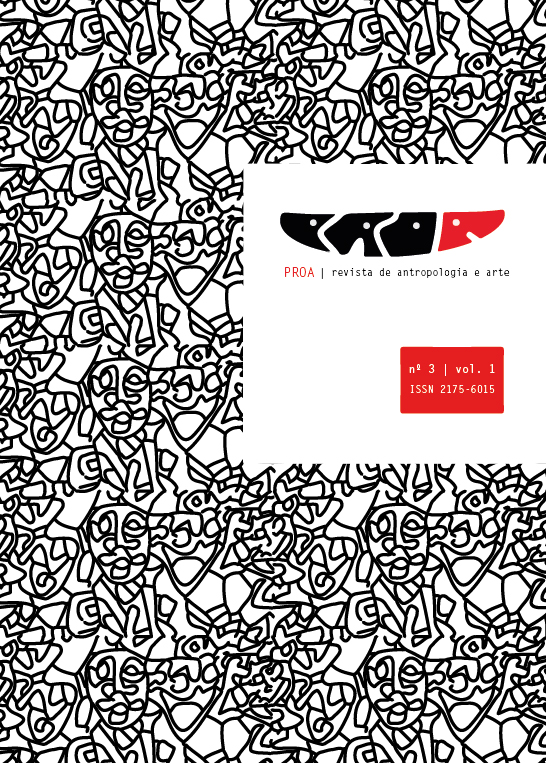Resumen
Este artículo dialoga con los argumentos teóricos del libro de Alfred Gell Art and Agency. Se sugiere que Gell, aunque defiende enfáticamente una perspectiva orientada a la acción, desvía la atención de la agencia humana al atribuir agencia a los objetos. Se argumenta que las mismas propiedades del arte que Gell excluye de su definición de objeto artístico y, en gran medida, de su análisis -estéticas y semánticas- son esenciales para entender el arte como una forma de actuar en el mundo y el impacto que las obras de arte tienen en las personas.
Citas
Arnaut, K. A Pragmatic Impulse In The Anthropology Of Art? Alfred Gell And The Semiotics Of Social Objects. Journal Des Africanistes, V. 71, N. 2, Pp. 191–208, 2001.
Bowden, R. A Critique Of Alfred Gell On Art And Agency. Oceania, V. 74, N. 4, Pp. 309–24, 2004.
Boyer, P. The Naturalness Of Religious Ideas: A Cognitive Theory Of Religion. Berkeley: University Of California Press, 1994.
Campbell, S. The Art Of Kula. London: Berg, 2002.
Errington, S. The Death Of Authentic Primitive Art And Tales Of Progress. Berkeley: University Of California Press, 1998.
Fischer, J.L. Art Styles As Cultural Cognitive Maps. American Anthropologist, V. 63, N. 1, Pp. 79–9, 1961.
Gell, A. “The Technology Of Enchantment And The Enchantment Of Technology” In: J. Coote, J., Shelton, A. (Eds.) Anthropology, Art And Aesthetics. Oxford: The Clarendon Press, 1992. Pp. 40–67
Gell, A. Wrapping In Images: Tattooing In Polynesia. Oxford: The Clarendon Press. 1993.
Gell, A. Vogel’s Net: Traps As Artworks: Artworks As Traps. Journal Of Material Culture, V. 1, N.1, Pp. 15–38, Pp. 1996
Gell, A. Art And Agency. Oxford: The Clarendon Press, 1998.
Guss, D. To Weave And Sing: Art, Symbol And Narrative In The South American Rainforest. Berkeley: University Of California Press, 1989.
Hanson, A. When The Map Is The Territory: Art In Maori Culture. In: Washburn, D. K. (Ed.) Structure And Cognition In Art. Cambridge: Cambridge University Press, 1983. Pp. 74–89
Hoskins, J. Agency, Biography And Objects. In: Tilley, C., Keane, K., Küchler, S., Rowlands, M. (Eds.). Handbook Of Material Culture. London: Sage, 2006. Pp. 74–84
Ingold, T. (Ed.) Key Debates In Anthropology (Debate: ‘aesthetics Is A Cross-Cultural Category’, Presentations For The Motion By J. Coote And H. Morphy). London: Routledge, 1996.
Johnson, M.H. On The Nature Of Theoretical Archaeology And Archaeological Theory. Archaeological Dialogues, V. 13, N. 2, Pp. 117–32, 2006
Layton, R. Art And Agency: A Reassessment. The Journal Of The Royal Anthropological Institute, V. 9, N. 3, Pp. 447–64, 2003.
Lipset, D. Dead Canoes: The Fate Of Agency In Twentieth-Century Murik Art. Social Analysis, V. 49, N. 1, Pp. 109–40, 2005.
Morphy, H. Ancestral Connections: Art And An Aboriginal System Of Knowledge. Chicago: University Of Chicago Press, 1991.
Morphy, H. “From Dull To Brilliant: The Aesthetics Of Spiritual Power Among The Yolngu”. In: Coote, J., Shelton, A. (Eds.) Anthropology, Art And Aesthetics. Oxford: The Clarendon Press, 1992. Pp. 181–208.
Morphy, H. Becoming Art: Exploring Cross-Cultural Categories. Oxford: Berg, 2007.
Morphy, H., Perkins, M. The Anthropology Of Art: A Reader. Oxford: Blackwell, 2006.
O’hanlon, M. Modernity And Graphicalization Of Meaning: New Guinea Highland Shield Design In Historical Perspective. Journal Of The Royal Anthropological Institute, 1(September), Pp. 469–92, 1995.
Price, S. Primitive Art In Civilised Places. Chicago: University Of Chicago Press, 1989.
Thomas, N., Pinney, C., (Eds.) Beyond Aesthetics: Art And The Technologies Of Enchantment. Oxford: Berg, 2001.
Winter, I. “Agency Marked, Agency Ascribed: The Affective Object In Ancient Mesopotamia”. In: Osborne, R., Tanner, J. (Eds.) Art’s Agency And Art History,. Oxford: Blackwell, 2007. Pp. 42–69

Esta obra está bajo una licencia internacional Creative Commons Atribución 4.0.
Derechos de autor 2016 PROA - Revista de Antropologia e Arte
